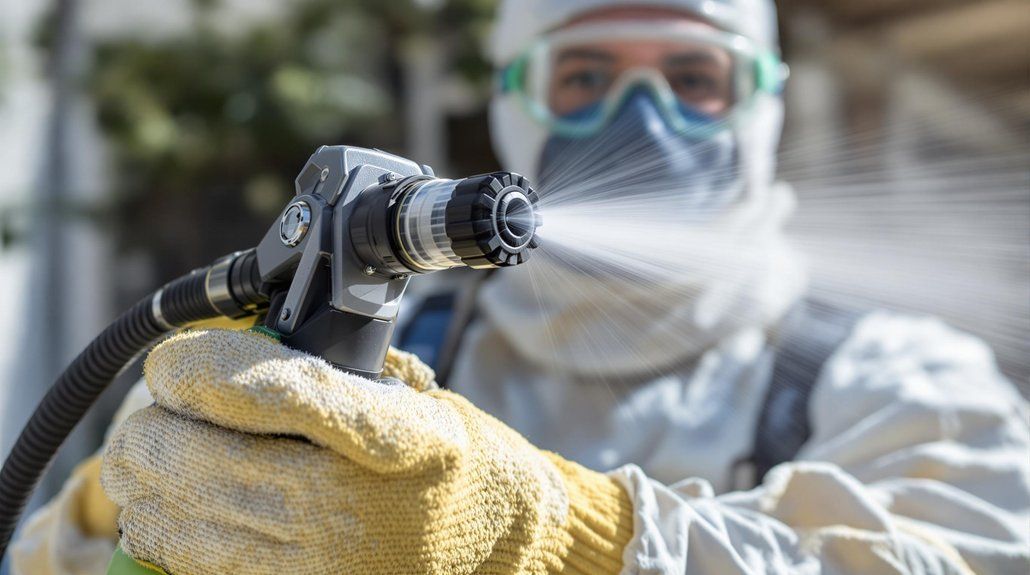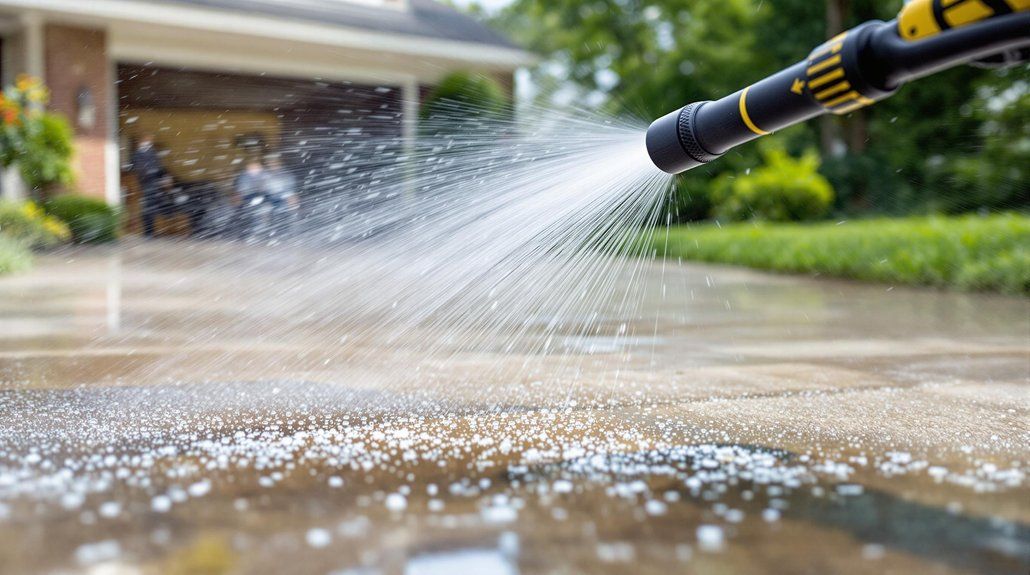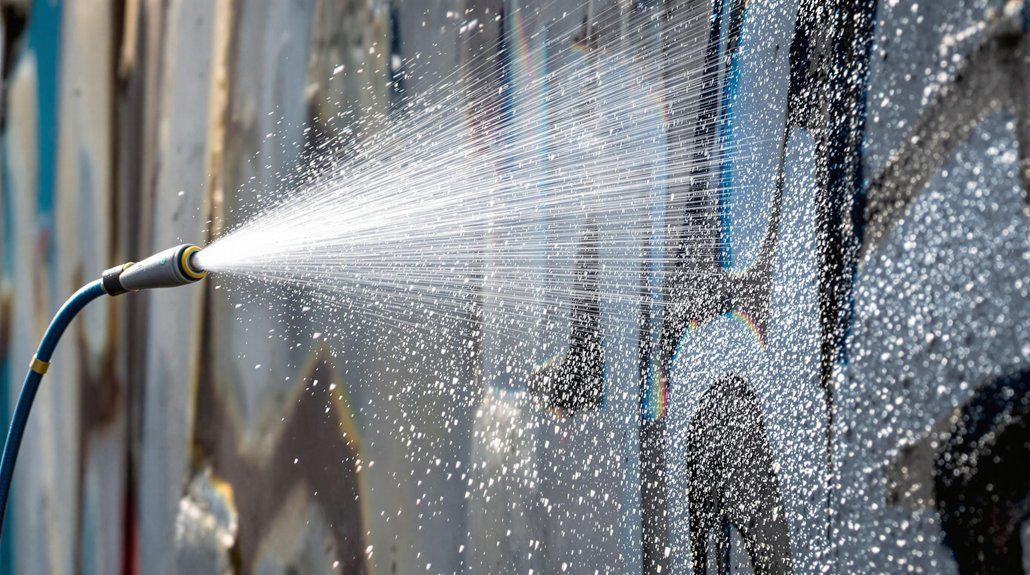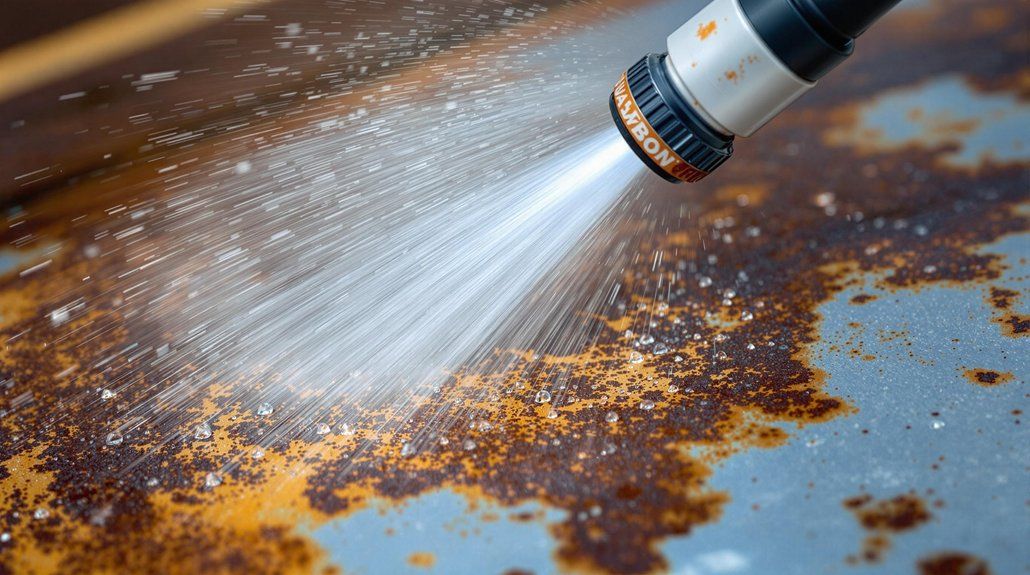Are Pressure Washing Chemicals Safe?
When you're dealing with pressure washing chemicals, you're exposing yourself and the environment to potential hazards. Chemicals can become airborne and inhalable during aerosolization, and runoff can pollute water bodies, harming aquatic life. Harsh cleaning solutions like bleach and petroleum-based solvents pose significant environmental dangers. To mitigate risks, use eco-friendly and EPA-compliant cleaning agents, proper training, safety gear, and water recovery systems. You'll want to understand more about how to manage these risks effectively to ensure safety, from proper handling practices to regulatory compliance, to make informed decisions about pressure washing chemical use.
Chemical Safety Risks
When you're working with pressure washers, aerosolization poses a significant threat. It can turn liquids on machinery, including lethal chemicals, into airborne particles that you can breathe in. This means that if you're not wearing the proper safety gear, you're exposed to these hazardous substances.
Moreover, pressure washing can cause chemical runoff into storm drains, which often lead directly to rivers, lakes, or oceans without treatment. This can pollute water bodies, harm aquatic life, and disrupt ecosystems.
Many pressure-washing tasks rely on cleaning solutions that contain harsh chemicals, such as bleach or petroleum-based solvents, which pose environmental risks.
To minimize these risks, it's crucial to follow best practices. This includes proper training, wearing safety gear, adhering to lockout/tagout procedures, and implementing water recovery systems.
Being aware of and following environmental guidelines is also critical in minimizing the ecological impact of pressure washing. By taking these precautions, you can protect yourself and the environment from the hazards associated with pressure washing chemicals.
Using eco-friendly pressure washing chemicals and EPA-compliant cleaning agents can further help mitigate environmental impacts.
Additionally, only trained personnel should operate pressure washers, as high-pressure jets can cause severe bodily harm and uncontrolled machinery can lead to accidents.
Impact on Human Health
To protect yourself, using proper personal protective equipment (PPE) is crucial.
Ensure you wear protective gear such as gloves, goggles, and a mask to minimize exposure to harmful substances.
Additionally, it's best to leave pressure washing tasks to trained professionals who know how to handle the equipment and chemicals safely.
Regular maintenance and inspection of pressure washers can also help prevent accidents.
Exposure to chemicals can lead to serious health issues, especially if not managed properly with chemical handling expertise.
Environmental Considerations
By choosing biodegradable detergents, conserving water, and employing optimized techniques, you can minimize the environmental impact of pressure washing.
Soft washing, which uses lower pressures and eco-friendly agents, is also a sustainable alternative.
Pressure washing can use up to 80 percent less water than a standard garden hose without an automatic shutoff nozzle water efficiency gains.
Safe Handling Practices
Store chemicals in their original containers, tightly sealed, and in a cool, dry place out of reach of children and pets.
Label containers clearly to avoid mix-ups and ensure proper use. Follow local guidelines for disposing of chemical waste.
Never mix different chemicals unless explicitly directed by the manufacturer, as this can lead to dangerous reactions.
Ensure adequate ventilation in the work area to prevent inhalation of fumes.
Use the correct nozzle type and pressure setting for the task to avoid injury and damage.
Finally, be prepared to respond to spills by following proper clean-up procedures.
When using pressure washing chemicals, always Wear Personal Protective Equipment (PPE) to safeguard against chemical exposure and potential harm.
Eco-Friendly Alternatives
Eco-friendly pressure washing chemicals offer a safer, more environmentally conscious alternative to traditional cleaning agents. These biodegradable and non-toxic substances break down naturally over time, reducing the risk of environmental harm and protecting plants and animals.
When you opt for eco-friendly chemicals, you also choose products that are certified by reputable environmental organizations like EPA's Safer Choice, ensuring a commitment to sustainability.
Using eco-friendly pressure washing chemicals not only safeguards the environment but also enhances health and safety by minimizing exposure to harsh chemicals. These chemicals are gentle on surfaces, too, cleaning effectively without causing damage to delicate materials.
This approach also complies with environmental regulations, promoting sustainable practices and reducing the risk of fines or penalties. Furthermore, eco-friendly pressure washing supports water conservation by utilizing low-flow pressure washers and soft washing techniques, ensuring effective cleaning with minimal water usage.
Professional pressure washing services utilize eco-friendly solutions and trained technicians to prevent damage and ensure thorough cleaning, particularly important for commercial buildings where maintaining appearance is crucial.
Regulatory Compliance
You must navigate a complex web of regulations when using pressure washing chemicals, making regulatory compliance crucial to avoid fines and legal issues. The Environmental Protection Agency (EPA) provides incentives for entities that voluntarily correct and prevent environmental breaches. If you meet the EPA's conditions, you can reduce gravity-based penalties by up to 75%.
To comply with EPA regulations, you should use only specific detergents and industrial soaps approved for pressure washing. Prohibited chemicals are those that harm the environment and public health. Ensure you implement safety measures for chemical usage and adhere to local authorities' strict requirements for wastewater disposal.
Regular training and certification are essential to ensure your staff understands compliance requirements. Certified operators are better equipped to handle regulatory challenges.
Small businesses, defined as those with fewer than 100 employees, can benefit from lighter compliance policies under EPA guidelines. Stay informed about local laws and industry standards by consulting with regulatory agencies and industry associations. Review and update your compliance practices regularly to ensure you're always meeting the necessary standards. This proactive approach helps prevent fines and legal issues, ensuring a safe and responsible pressure washing operation.
Conclusion
You must handle pressure washing chemicals with care to avoid health risks and environmental damage. Chemicals can cause skin and eye damage, respiratory problems, and long-term health issues if not used properly. Always follow safe handling practices, wear protective gear, and consider eco-friendly alternatives. Additionally, ensure you comply with regulatory standards to minimize risks and protect the environment. By taking these precautions, you can safely use pressure washing chemicals for effective cleaning.



